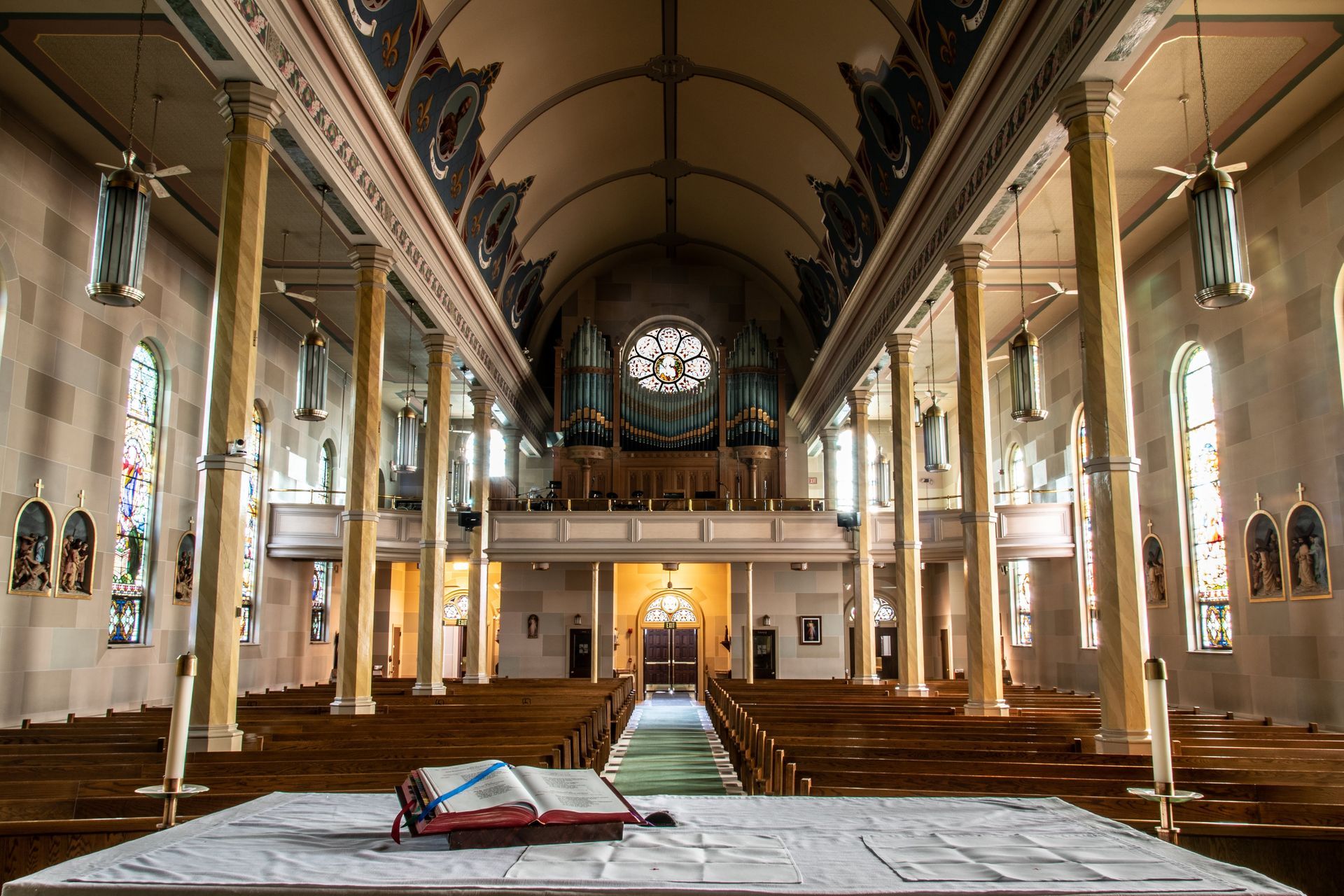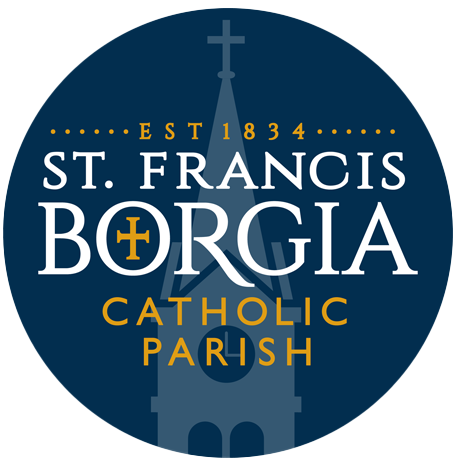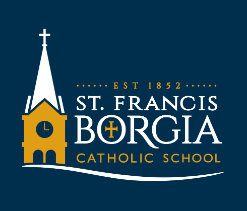Our Church
St. Francis Borgia Catholic Church
A Historical Society Scholarship Video
By Sophie Straatmann
SFB Parish History
Our Historic Church
- 1833 - Twelve Catholic families arrive on the shores of the Missouri River in what is now called Washington. These families include Bleckmann, Buhr, Edelbrock, Hustermann, Koering, Riegel, Schwegmann, Smertmann, Trentmann, Uhlenbrock, Uhlenbrock and Weber
- 1834 - First Easter Mass celebrated by Father Verreydt, a Jesuit, at a hotel in the area.
- 1838 - Small log church is built. The parish is ministered to by Jesuits.
- 1841 - St. Rose Philippine Duchesne visits St. Francis Borgia (She was canonized July 3rd, 1988)
- 1846 - Second brick church is built just west of the current church on land donated by John F. Mense. It is small in comparison to today’s church and stands 36 feet x 70 feet.
- 1856 - Catholic elementary instruction begins.
- 1859 - The School Sisters of Notre Dame begin teaching at the church school with the arrival of Sister Pia Blunde, Sister Anna Busemann and Candidate Magdalena Bauer, a blessing that continued uninterrupted for 150 years. From Borgia parish two other SSND missions were established: St. Gertrude’s in Krakow Missouri, and Our Lady of Lourdes here in Washington.
- 1869 - Third and current church is completed and blessed on Easter Monday, April 6th 1869, Fr. Martin Seisel, SJ is the pastor
- 1869 - Three bell tower bells are blessed: one in honor of Saint Francis Borgia weighing 3160 pounds, and two in honor of the Blessed Virgin weighing 1590 and 868 pounds.
- 1883 - Rectory is built.
- 1884 - Catholic school building erected in what is now called Jesuit Hall.
- 1891 - Convent built.
- 1894 - Saint Francis Borgia was turned over from the Jesuits to the Franciscans (the barefoot priests) to staff.
- 1909 - Pipe organ installed in the church which is still used today.
- 1910 - Tornado tears steeple and part of the roof off the church.
- 1916 - Hibbeler house remodeled for a Convent for the School Sisters of Notre Dame in what is now called Notre Dame Hall.
- 1933 - Four year, fully accredited high school begins.
- 1935 - High school building completed in what is now the larger of the two grade school buildings.
- 1958 - Saint Francis Borgia divided into two parishes. The new parish is called Our Lady of Lourdes.
- 1982 - Saint Francis Borgia Regional High School opens off the parish campus. The grade school moves into the high school building.
- 1990 - Franciscan Fathers turn over administration of the parish to the priests of the Archdiocese of St. Louis.
- 2001 - Fire in the convent building is quickly contained, but damage is extensive.
- 2007 - Former school building is completely gutted, remodeled and becomes what is now known as Jesuit Hall.
- 2017 - Restoration work was completed on the church's historic stained glass windows which included the installation of new tempered glass covers providing better visibility of the windows outside and beautiful lighting inside.
- 2020 -The major church ceiling renovation saw the 100-year-old canvas paintings of the Twelve Apostles refreshed and the barrel ceiling repaired, plastered, and canvas covered. Names of each Apostle were added.
Original Church - 1838
In the early years of the settlement, the visiting Jesuit priest, Rev. Father Walters, urged the settlers to build at least a log church.
In the meantime, several other families had arrived, among whom were John Frederich Schwegmann, his mother, and several brothers. Although there were only fifteen families, they began to build the church on the land that had been bought by Rev. Father Verhaegen. This church was completed in the following spring of 1838, and it was a poor church. It faced south, and there was no bell in it.
The site was about one mile south of Washington near the present cemetery. Rev. Henry Meinkmann, a secular priest became the first pastor. He was succeeded one year later, in 1839, by Rev. James Busschots, S.J.
-- excerpts from St. Francis Borgia Centenary Jubilee Souvenir, 1834 - 1934
Second Church - Dedicated 1846
In 1840, a church was built above Marthasville called St. Ignatius Church, and another one on this side called St. Peter and Paul, later on called St. Vincent's.
Many families also gave several acres. In the meantime, however, several other families had arrived on this side of the river. The wooden church had been enlarged and already the people started to build a better one.
Mrs. Lucinda Owens, a widow, who last year acquired fifty acres, made a new attempt to found a town, which already on May 29, 1939, she laid out as the original town of Washington and which she had recorded in Union. For the purpose of erecting a new Catholic Church she offered four lots to the Catholics.
But several families did not want to leave the church. They even wanted to build a new and larger church on the old site, and in fact they began to build. Others, however, wanted to build a church in the town of Washington which was just beginning to spring up and began to be called New Washington.
The dispute was finally resolved in 1845 when Reverend Father Provincial Van de Velde came in person to declare by the order of the Archbishop that a church was to be built in Washington. As a means of compromise, the people decided that the church in Washington was to be made smaller, and when they finished, they might build another church in Krakow. And this was done.
The foundationthat had already been laid was altered (120 feet shorter), for which many people were later sorry. The parish was never separated, and hence,e it soon became necessary to build a new church.
An architectand his workmen came from St. Louis and began to build the church. However, the roof could not be put on until the spring of 1846 because the shingles could not be transported from St. Louis on the river in winter. In the spring of 1846, the roof was put on. Also,o the doors and windows were obtained from St. Louis ready-made. Reverend Provincial paid for them.
During the summer month, the carpenters finished their work inside the church, and on the feast of St. Francis Borgia, the new church was blessed under the title of this Saint by Rt. Reverend Bishop Barron, Liberia, Africa, whoe also administered the Sacrament of Confirmation.
The church was built of brick. It was 36 feet wide and 70 feet long. Hewn trunks of trees served as pews. The men occupied one side of the church, the ladies the other.
Now, Reverend Father Eisvogels ceased his ministry in the old church at the cemetery, which was taken down and again put up as a school in Washington on Main and Elm streets.
As the church became too small, a gallery, which cost $300, had to be built, and it became necessary to attend to the spiritual wants of the Irish workingmen along the railroad for twenty-six miles.
In November 1853, Reverend Father Martin Seisl, who had been stationed at St. Joseph’s Church in St. Louis, was sent to Washington. The work was now divided in the following manner: Reverend Father Seisl took charge of Washington; FG Eisvogels took care of the workingmen along the railroad, and Reverend Father H. Van Mierlo went to the neighboring stations.
Reverend Father Seisl first procured a sanctuary lamp for the church. The church was so small that building a balcony in the rear and along the sides of the church became necessary. But when the men were about to place the pillars, it was found that the church floor was very rotten since in building the church, no provisions had been made to let the air pass out under the floor. Hence, a collection was first created for a new floor. The farmers brought hewn timber for the joists, and on an appointed day, the whole parish came together and removed the old and rotten wood, dug out the cellar, made air holes, and laid the new joists and flooring. In the evening, they sold the old flooring to the highest bidder. Also, new pews were procured for the church.
-- excerpts from St. Francis Borgia Centenary Jubilee Souvenir, 1834 - 1934
The Beginnings
The parish grew in the course of years, so that by 1860 the parish numbered one hundred and fifty families.
"It became more and more evident that a new building had to be constructed or an addition put to the old church. However, on account of the war and the invasion of the enemy, this had to be deferred. It was in 1866 that the plan of building a church had been accepted, and work was begun at once. A contract having been made for the stones, they began to haul them on January 2, 1866, and towards the end of the winter the earth was dug up and the foundation was gradually laid."
-- exerpts from St. Francis Borgia Centenary Jubilee Souvenir, 1834 - 1934
Cornerstone Ceremony
Ascension Day, the 10th of May, 1866, had been appointed as the day for laying and blessing the cornerstone of the new church.
On the day before the feast of the Ascension, the Most Reverend Archbishop arrived with Reverend Father Scheider and the Master of Ceremonies, Reverend Lynch. Early next morning His Grace said Holy Mass.The School Society and the Young Men's Sodality with their banners went out to meet the procession coming from St. John's and St. Gertrude’s churches. After they had entered the church, Solemn High Mass was celebrated, during which the Archbishop himself preached. After High Mass he administered the Sacrament of Confirmation to a class of about two hundred (including those who had come from other parishes).
When he was finished at 11 :00 o'clock, the entire parish with five banners marched through the town in procession to the depot to receive the people who came from St. Louis for this solemn occasion. There were about 300, amongst them Reverend Goller and son, Jesuit Fathers, Scholastics and Brothers. To revive the tired body, dinner was prepared for the guests near the church. No price was fixed; each dropped as much as he wished into the collection box.
At one o'clock the Archbishop first blessed the banners of the Ladies' Society, of the Holy Childhood, and of the Sodality which bore the picture of St. Aloysius. Thereupon a procession was formed to the new foundation, and after the blessing of the cornerstone the clergy and the ministers ascended a platform that had been erected between the house and the new foundation. Reverend Father Tschieder preached in German and Reverend Father Gareche in English. The solemnity being over, and the Archbishop having imparted his blessing, the guests took a short supper and left for home on the train.
-- excerpts from St. Francis Borgia Centenary Jubilee Souvenir, 1834 - 1934
Church Construction
On April 4, 1867, the bricklayers began their work. 650,700 bricks were used, and they cost $4,717. The laying of the bricks lasted until October, and the wages that had to be paid to the bricklayers amounted to $3,811. In the meantime, the carpenters under the superintendence of Brother Heilers, S. J., whom Reverend Provincial had sent for this purpose, prepared the joists, the pillars, and finally they put up the framework and covered the roof. In October plasterers came from St. Louis to plaster the walls and the ceiling. They made a contract to do the work for $1,400. They finished on November 22. The stained-glass windows were procured from Buffalo. M. Hastings undertook to decorate the church at $5 a day, and the entire decorations cost about $1,000.
As three years had been allotted to the parishioners to pay their subscriptions, Reverend Father Seisl called the congregation into the church when it was under cover, and asked them whether they wished to leave the church as it was until the following year, until the rest of the money should be paid, or whether they preferred to complete the church immediately, in which case the money would also have to be paid in the same year. All were in favor of completing the church without interrupting the work.
At the advice of Brother Heilers, the pews were to be made in St. Louis. But as the whole factory burned down, also the pews were consumed by the flames, thus entailing a loss of $550. Hence Reverend Father Seisl was compelled to take up a collection in the neighboring parishes. In November Joseph Mintrup on his deathbed bequeathed $500 for an altar in honor of St. Joseph while another, Henry Strubberg, gave the means for making the tabernacle.
On July 4 the bells were blessed by Rev. Fr. Provincial, who also gave the English sermon, whilst Rev. Fr. Paulinus Tolksdorf, 0. F. M., preached in German.
The bells are:
- In honor of St. Francis Borgia, weighing 3,160 pounds
- The second one in honor of the Blessed Virgin, weighing 1,590 pounds
- The third one in honor of the Blessed Virgin, weighing 868 pounds
-- excerpts from St. Francis Borgia Centenary Jubilee Souvenir, 1834 - 1934
The High Altar
The high altar was built and put up by Schwarzer and Co. The pulpit, costing $371.96, was donated by the Young People's Sodality (contributing $250); the deficit being made up by the parish. The communion railing was made by Trentmann and Co., costing $201.43. It was used for the first time on May 5, the occasion of the First Holy Communion. Various Sodalities donated altar linens and vestments. The Baptismal Font was donated by the Ladies' Sodality, costing $210. An iron enclosure was made around the Baptismal Font as a kind of chapel, by A. Jasper, for which the Ladies' Sodality donated $92.50. The beautiful statues of the Most Sacred Heart and of the Blessed Virgin Mary were procured with the help of benefactors and placed in the sanctuary of the church.
Church Dedication
Easter Monday (April 6, 1869) was the day appointed for blessing the new church. Vicar General, Milcher, had promised to come for this purpose but, being hindered through sickness, he wrote and told Reverend Father Seisl to appoint one of the priests present to do it. Reverend Provincial Fred Coosemans, Reverend Goller, Reverend Faeber, Rev. Fr. Braun, Rev. Fr. Copmans, Rev. Fr. Lamblin were present. After some opposition, Rev. Provincial was persuaded to undertake the blessing. Reverend Fr. Goller and Rev. Fr. Wm. Faeber assisted, whilst Rev. Fr. Haza sang the High Mass.
The Blessed Sacrament was carried over in solemn procession, despite the rain. The weather with the preceding rain hindered many from attending the solemnity.




